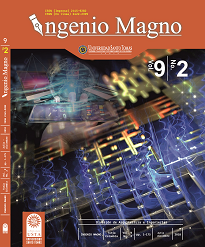Use of mobile technologies applied to the teaching of orthogonal projections in the course expresión gráfica I
Main Article Content
Abstract
Downloads
Article Details
DECLARATION OF ORGINIALITY OF SUBMITTED ARTICLE
With this document, I/We certify that the article submitted for possible publication in the institutional journal INGENIO MAGNO of the Research Center Alberto Magno CIIAM of the University Santo Tomás, Tunja campus, is entirely of my(our) own writing, and is a product of my(our) direct intellectual contribution to knowledge.
All data and references to completed publications are duly identified with their respective bibliographical entries and in the citations thus highlighted. If any adjustment or correction is needed, I(we) will contact the journal authorities in advance.
Due to that stated above, I(we) declare that the entirety of the submitted material is in accordance with applicable laws regarding intellectual and industrial property, and therefore, I(we) hold myself(ourselves) responsible for any complaint related to it.
If the submitted article is published, I(we) declare that I(we) fully relinquish publishing rights of the article to the University Santo Tomás, Tunja campus. As remuneration for this relinquishment of rights, I(we) declare my(our) agreement to receive two (2) copies of the edition of the journal in which my(our) article appears.
References
De la Torre C., J., Martin D., N., Saorín P., J. L., Carbonell C., C. y Contero G., M. (2013). Entorno de aprendizaje ubicuo con realidad aumentada y tabletas para estimular la comprensión del espacio tridimensional. RED. Revista de Educación a Distancia, Núm. 37, 1-17
Font O., C. (2015) Desarrollo de la capacidad espacial en el alumnado de dibujo técnico I a través de la realidad aumentada. Trabajo fin de master, Universidad internacional de la Rioja, España.
Gardner, H. (1987). The theory of multiple intelligences. Annals of Dyslexia, Vol. 37, 19-35
López H., F. A. y Silva P., M. M. (2014) M-learning patterns in the virtual classroom. Universities and Knowledge Society Journal, vol. 11, núm. 1, 208-221.
Martín G., J. (201 O) Estudio y evaluación de contenidos didácticos en el desarrollo de las habilidades espaciales en el ámbito de ingeniería. Vol 1, Universidad politécnica de Valencia, España.
Moreno Torres, ó., Albarracín Beltrán, M. y Abril Medina, C. (2015). Desarrollo de un modelo de integración de servicios web 2.0 basado en educación 3.0. Ingenio Magno, 6(2), 10-20
Organista S., J., McAnally S., L y Lavigne G. (2013). El teléfono inteligente (smartphone) como herramienta pedagógica. Revista Apertura, vol. 5, núm. 1, abril, 2013, 6-19.
Santamaría Granados, L. y Mendoza Moreno, J. F. (201 O) Realidad Virtual: Potencial Educativo. Ingenio Magno, vol 1, 6-15.
Saorín, J. L., Navarro T., R., Martín D., N. y Contero, M. (2005). Las habilidades espaciales y el programa de expresión gráfica en las carreras de ingeniería, ICECE 2005.
Tristancho O., J. A., Vargas T., L. F. y Contreras B., L. E. (2014) Evaluación de técnicas tradicionales y TIC para el desarrollo de habilidades espaciales en estudiantes de primer semestre de ingeniería industrial. Revista Virtual Universidad Católica Del Norte, Vol. 43, 34-50.

